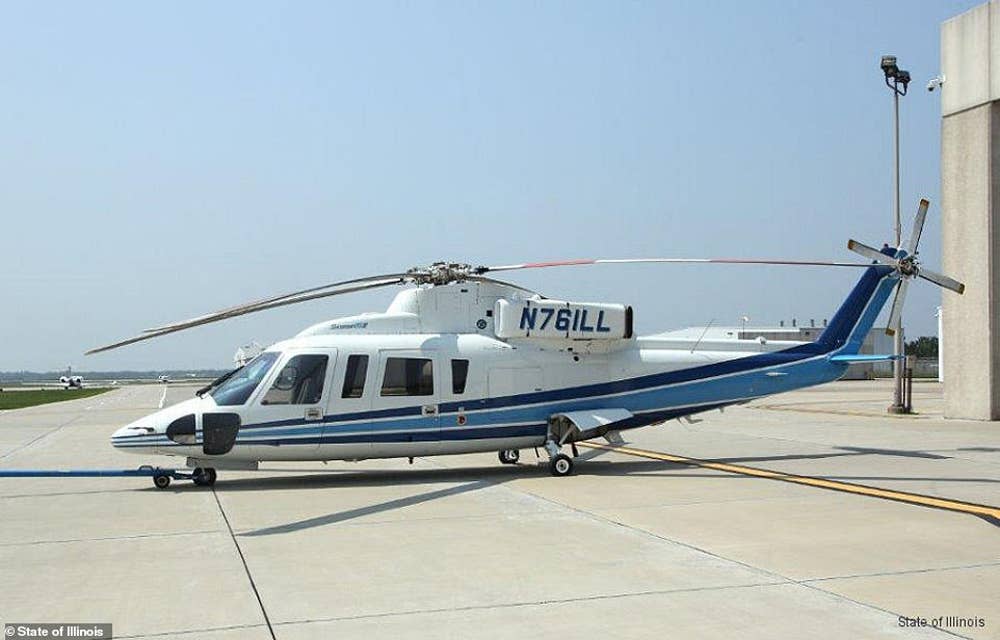
The helicopter flown for Kobe Bryant was originally known as 761LL when it was property of the State of Illinois. State of Illinois
Investigators at the site of the January 26 crash of a Sikorsky S-76 helicopter—which claimed the lives of basketball legend Kobe Bryant, his young daughter and seven others—said the aircraft missed clearing the hill it struck near Calabasas, California, by some 30 feet. National Transportation Safety Board investigator Bill English made a point during a press conference the next day to explain that, while clearing that ridge might have provided a few precious seconds to the pilot as he apparently struggled to regain control of the machine, there were other nearby hills that certainly would have posed additional threats. The accident flight, conducted under Part 135 rules, was tracked on radar while it was operating under special VFR conditions near Burbank and then through the Van Nuys area before it eventually disappeared in the hills along Highway 101 near Calabasas on that Sunday morning.
Early media reports following the accident used terminology like, “FAA Cleared Bryant Helicopter to Fly,” a clear reference to the special VFR clearance issued by ATC at both Burbank and Van Nuys. While those headlines seemed to imply ATC was somehow responsible in the accident, a special VFR clearance required the helicopter’s pilot, Ara Zobayan, to remain clear of clouds at all times. At the time of the accident, the area around and west of Van Nuys was shrouded in dense fog. Though Zobayan was instrument rated, there is no evidence the 1991 vintage S-76B was equipped and current for instrument flight. The pilot held a second class medical and had logged 8,200 hours as of July 2019, with approximately 1,250 hours of time on the S-76. He’d been employed by Island Express Helicopters, the company operating the helicopter for Bryant, for 10 years. Investigators will also be looking into the scheduling of the helicopter on that Sunday morning to determine if anything might have influenced the pilot to press on into poor weather. An unverified audio/radar track created by VASA Aviation purports to show the last few minutes of the flight.
The NTSB’s on-site board member Jennifer Homendy revealed a number of known facts about the flight and the helicopter. She said ADS-B data showed, “the copter was at 2,300 feet when it lost communications with ATC and that the impact occurred at a descent rate of more than 2,000 feet per minute [with the helicopter] in a descending left bank.” She said Bryant’s helicopter was not equipped with a terrain avoidance and warning system. It is impossible to be certain an on-board TAWS would have prevented the accident at the speed—approximately 140 knots—at which the machine was traveling. Homendy said an iPad loaded with ForeFlight was also uncovered at the crash site, though the device’s owner has not yet been identified.
Homendy added a number of insights to the briefing, explaining that in 2004 the NTSB sent the FAA a recommendation to require all existing and new U.S.-registered turbine rotorcraft with six or more passenger seats be required to have a TAWS on board. The FAA never implemented the recommendation, and the Board eventually dropped its pressure on the agency, marking the agency response as “unacceptable.” In 2005 the NTSB assisted in a Baltic Sea crash of another S-76 and recommended to the FAA at that time that all civil helicopters under Part 91 and Part 135 be equipped with a cockpit voice and flight data recorders. The FAA also failed to act on that recommendation.
The S-76 is a large aircraft, capable of seating as many as 13 and weighing in just under 12,000 pounds at max gross weight. Sources believe Bryant’s helicopter was configured for approximately eight passengers. Bryant’s helicopter, N72EX, was purchased in 2015 from the State of Illinois when that state’s then-governor decided aircraft were an unnecessary extravagance.
Flying’s popular Aftermath columnist Peter Garrison happened to be 20 miles away from the accident site on that Sunday morning and said there were dense clouds in the area with no sun peeking through at his location. After reviewing some of the public tracking data available including the rather abrupt pull up the Sikorsky’s pilot executed during the last minute of the flight, Garrison said, “I think it’s possible that in the process of trying climb above the clouds, he became disoriented and perhaps was reacting to some powerful physical sensations before the helicopter slid into the ground.” The helicopter, in one piece when it struck the ground, disintegrated along the ground projecting the contents of the cabin out ahead of the aircraft.” Garrison said the NTSB will “certainly be looking into what part of the helicopter stuck the ground first.”

Sign-up for newsletters & special offers!
Get the latest FLYING stories & special offers delivered directly to your inbox






